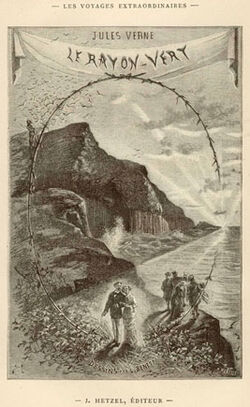The Green Ray (French: Le Rayon vert) is a novel by Jules Verne published in 1882 and named after the optical phenomenon of the same name. It is referenced in an eponymous 1986 film by Eric Rohmer.
Synopsis[]
The characters are trying to observe the green ray in Scotland. After numerous failures, the phenomenon is eventually visible; but the characters, finding love in each other, don't pay attention to the horizon.
Science[]
Green flashes and green rays are rare optical phenomena that occur shortly after sunset or before sunrise, when a green spot is visible for a short period of time above the sun, or a green ray shoots up from the sunset point. It is usually observed from a low altitude where there is an unobstructed view of the horizon, such as on the ocean. The idea in the novel that one can predict where and when to observe the green ray has no scientific basis.
Cited in Eric Rohmer's 1986 film, the green ray is used as a central image providing meaning and guidance for the film's troubled main character, Delphine. Verne's book is discussed at length in the film as a "fairytale love story" whose protagonists are consumed in their search for the rare meteorological phenomenon. Believed to give a heightened perception to those who view it, one of the characters further explains that "when you see the green ray you can read your own feelings and others too." Seizing this idea, Delphine uses her own search for the "rayon vert" to help overcome her fear of intimacy.
| This page uses Creative Commons Licensed content from Wikipedia (view authors). | 
|

